Epson ActionNote 4SLC-25 User Manual


FCC COMPLIANCE STATEMENT
FOR AMERICAN USERS
This equipment has been tested and found to comply with the limits for a class B digital device, pursuant to Fart 15 of the FCC Rules. These limits are designed to provide reasonable protection against harmful interferencein a residential installation This equipment generates, uses, and can radiate radio frequency energy and, if not installed and used in accordance with the instructions, may cause harmful interference to radio and television reception However, there is no guarantee that interference will not occur in a particular installation If this equipment does cause interference to radio and television reception, which can be determined by turning the equipment off and on, the user is encouraged to try to correct the interference by one or more of the following measures:
Reorient or relocate the receiving antenna
Increase the separation between the equipment and receiver
Connect the equipment into an outlet on a circuit different from that to which the receiver is connected
Consult an experienced radio/TV technician for help.
WARNING
The connection of a non-shielded equipment interface cable to this equipment will invalidate the FCC Certification of this device and may cause interference levels that exceed the limits established by the FCC for this equipment. It is the responsibility of the user to obtain and use a shielded equipment interface cable with this device. If this equipment has more than one interface connector, do not leave cables connected to unused
i n t e r f a c e s .
Changes or modifications not expressly approved by the manufacturer could void the user’s authority to operate the equipment.
FOR CANADIAN USERS
This digital apparatus does not exceed the Class B limits for radio noise emissions from digital apparatus as set out in the radio interference regulations of the Canadian Department of Communications.
Le present appareil numérique n’émet pas de bruits radioélectriques dépassant les limites applicables aux appareils numériques de Classe B prescrites dans le règlement sur le brouillage radioélectrique édicté par le Ministére des Communications du Canada.

IMPORTANT NOTICE
DISCLAIMER OF WARRANTY
Epson America makes no representations or warranties, either express or implied, by or with respect to anything in this manual, and shall not be liable for any implied warranties of merchantability and fitness for a particular purpose or for any indirect, special or consequential damages. Some states do not allow the exclusion of incidental or consequential damages, so this exclusion may not apply to you
COPYRIGHT NOTICE
All rights reserved. No part of this publication may be reproduced, stored in a retrieval system, or transmitted, in any form or by any means, electronic, mechanical, photocopying, recording or otherwise, without the prior written permission of Epson America, Inc. No patent liability is assume with respect to the use of information contained herein. Nor is any liability assumed for damage resulting from the use of the information contained herein Further, this publication and features described herein are subject to change without notice.
TRADEMARKS
Epson is a registered trademark of Seiko Epson Corporation
ActionNote is a trademark of Epson America, Inc.
General notice: Other product names used herein are for identification purposes only and may be trademarks of their respective companies.
Copyright © 1993 by Epson America, Inc. |
400210900 |
Torrance, California |
ii

Important Safety Instructions
1.Read all of these instructions and save them for later reference.
2.Follow all warnings and instructions marked on the computer.
3.Unplug the computer from the wall outlet before cleaning. Use a damp cloth for cleaning; do not use liquid or aerosol cleaners.
4.Do not spill liquid of any kind on the computer.
5.Do not place the computer on an unstable cart, stand, or table.
6.Slots and openings in the cabinet and the back or bottom are provided for ventilation; do not block or cover these openings. Do not place the computer near or over a radiator or heat register.
7.Operate the computer using the type of power source indicated on its label.
8.If you plan to operate the computer in Germany, observe the following safety precaution:
To provide adequate short-circuit protection and over-current protection for this computer, the building installation must be protected by a 16 Amp circuit breaker.
Beim Anschluß des Computers an die Netzversorgung muß sichergestellt werden, daß die Gebäudeinstallation mit einem 16 A Überstromschutzschalter abgesichert ist.
9.Connect all equipment to properly grounded (earthed) power outlets. If you are unable to insert the plug into an outlet, contact your electrician to replace your outlet. Avoid using outlets on the same circuit as photocopiers or air control systems that regularly switch on and off.
iii

10.Do not allow the computer’s power cord to become damaged or frayed.
11.If you use an extension cord with the computer, make sure the total of the ampere ratings of the devices plugged into the extension cord does not exceed the ampere rating for the extension cord. Also, make sure the total of all products plugged into the wall outlet does not exceed 15 amperes.
12.Do not insert objects of any kind into this product through the cabinet slots.
13.Except as specifically explained in this User’s Guide, do not attempt to service the computer yourself. Refer all servicing to qualified service personnel.
14.Unplug the computer from the wall outlet and refer servicing to qualified service personnel under the following conditions:
A.When the power cord or plug is damaged.
B.If liquid has entered the computer.
C.If the computer does not operate normally when the operating instructions are followed. Adjust only those controls that are covered by the operating instructions. Improper adjustment of other controls may result in damage and often requires extensive work by a qualified technician to restore the computer to normal operation.
D.If the computer has been dropped or the cabinet has been damaged.
E.If the computer exhibits a distinct change in performance.
iv

Instructions Importantes de Sécurité
1.Lire complètement les instructions qui suivant et les conserver pour références futures.
2.Bien suivre tous les avertissements et les instructions indiqués sur l’ordinateur.
3.Débrancher l’ordinateur de toute sortie murale avant le nettoyage. Ütiliser un chiffon humide; ne jamais utiliser un nettoyeur
liquide ou une bonbonne aérosol.
4.Ne jamais renverser un liquide d’aucune sorte sur l’ordinateur.
5.Ne pas placer l’ordinateur sur un chariot, un support, ou une table instable.
6.Les events dans le meubles, à l’arrière et en dessous sont conçus pour l’aération; on ne doit jamais les bloquer. Ne pas placer l’ordinateur près d'une source de chaleur directe.
7.Le fonctionnement de l’ordinateur doit s’effectuer conformément au type de source d’alimentation indiquée sur l’étiquette.
8.Lorsqu’on désire utiliser l’ordinateur en Allemagne, on doit observer les normes sécuritaires qui suivent:
Afin d’assurer une protection adéquate à l’ordinateur contre les court-circuits et le survoltage, l’installation de l’édifice doit comprendre un disjoncteur de 16 amp.
9.On doit brancher tout l’équipement dans une sortie reliée à la masse. Lorsqu’il est impossible d’insérer la fiche dans la prise, on doit retenir les services d’un électricien ou remplacer la prise. Ne jamais utiliser une prise sur le même circuit qu’un appareil à photocopie ou un système de contrôle d’aération avec commutation marche-arrêt.
V

10.S’assurer que le cordon d’alimentation de l’ordinateur n’est pas effrité.
11.Dans le cas où on utilise un cordon de rallonge avec l’ordinateur, on doit s’assurer que la valeur totale d’ampères branches dans le cordon n’excède en aucun temps les amperes du cordon de rallonge. La quantité totale des appareils branches dans la prise murale ne doit jamais excéder 15 amperes.
12.Ne jamais insérer un objet de quelque sorte que ce soit clans les cavités de cet appareil.
13.Sauf tel que spéifié dans la notice d’utilisation, on ne doit jamais tenter d’effectuer une réparation de l’ordinateur. On doit référer le service de cet appareil à un technicien qualifié.
14.Debrancher l’ordinateur de la prise murale et confier le service au personnel de service qualifié% selon les conditions qui suivent:
A.Lorsque le cordon d’alimentation ou la prise sont endommagés.
B.Lorsqu’un liquide s’est infiltre dans l’ordinateur.
C.Lorsque l’ordinateur refuse de fonctionner normalement même en suivant les instructions. N’ajuster que les commandes qui sont étumérés clans les instructions de fonctionnement. Tout ajustement inadéquat de tout autre contrôle peut provoquer un dommage et souvent nécessiter des reparations élaborées par un technicien qualifié afin de remettre l’appareil en service.
D.Lorsqu’on a échappé l’ordinateur ou que l’on a endommagé le boîtier.
E.Lorsque l’ordinateur démontre un changement note au niveau de sa performance.
vi

Contents
Introduction |
|
|
Standard |
Configuration . . . . . . . . . . . . . . . . . . . . . . |
1 |
Optional |
Equipment . . . . . . . . . . . . . . . . . . . . . . . . |
3 |
Where to Get Help . . . . . . . . . . . . . . . . . . . . . . . . . |
3 |
|
How to Use This Manual . . . . . . . . . . . . . . . . . . . . . . |
5 |
|
Conventions Used in This Manual . . . . . . . . . . . . . . |
6 |
|
Chapter 1 Setting Up the Computer |
|
|
Unpacking the Computer . . . . . . . . . . . . . . . . . . . . . |
1-2 |
|
Identifying the System Parts . . . . . . . . . . . . . . . . . . . . |
1-3 |
|
Front View . . . . . . . . . . . . . . . . . . . . . . . . . . . |
1-3 |
|
Rear Panel and Left Side . . . . . . . . . . . . . . . . . . . |
1-6 |
|
Connecting the AC Adapter . . . . . . . . . . . . . . . . . . . . |
1-8 |
|
Opening the Screen . . . . . . . . . . . . . . . . . . . . . . . . . |
1-10 |
|
Turning On the Computer . . . . . . . . . . . . . . . . . . . . . |
1-11 |
|
Chapter 2 Using Your Computer |
|
|
Taking Care of the Computer . . . . . . . . . . . . . . . . . . . |
2-2 |
|
Copying the Reference Diskette Utilities . . . . . . . . . . . . . |
2-3 |
|
Using the Password Function . . . . . . . . . . . . . . . . . . . |
2-4 |
|
Typing the Password . . . . . . . . . . . . . . . . . . . . . |
2-4 |
|
Using the Keyboard . . . . . . . . . . . . . . . . . . . . . . . . . |
2-5 |
|
Special Keys . . . . . . . . . . . . . . . . . . . . . . . . . . |
2-7 |
|
Using F11 and F12 . . . . . . . . . . . . . . . . . . . . . . . |
2-8 |
|
Using the Embedded Numeric Keypad . . . . . . . . . . . |
2-9 |
|
Stopping a Command or Program . . . . . . . . . . . . . . . . |
2-9 |
|
vii

Resetting the Computer . . . . . . . . . . . . . . . . . . . . . . |
2-10 |
Turning Off the Computer . . . . . . . . . . . . . . . . . . . . . |
2-11 |
Changing the CPU Speed . . . . . . . . . . . . . . . . . . . . . |
2-11 |
Using the LCD Screen . . . . . . . . . . . . . . . . . . . . . . . |
2-12 |
Using Diskettes . . . . . . . . . . . . . . . . . . . . . . . . . . . |
2-12 |
Inserting and Removing Diskettes. . . . . . . . . . . . . . |
2-13 |
Write-protecting Diskettes . . . . . . . . . . . . . . . . . . |
2-14 |
Making Backup Copies . . . . . . . . . . . . . . . . . . . . |
2-15 |
Using a Single Diskette Drive System . . . . . . . . . . . . |
2-15 |
Using a Hard Disk . . . . . . . . . . . . . . . . . . . . . . . . . |
2-16 |
Backing Up the Hard Disk . . . . . . . . . . . . . . . . . . |
2-16 |
Saving Battery Power . . . . . . . . . . . . . . . . . . . . . |
2-17 |
Using Memory . . . . . . . . . . . . . . . . . . . . . . . . . . . . |
2-17 |
Chapter 3 Powering the Computer |
|
Using the AC Adapter . . . . . . . . . . . . . . . . . . . . . . . |
3-1 |
Using the Battery Pack . . . . . . . . . . . . . . . . . . . . . . . |
3-2 |
Replacing the Battery Pack . . . . . . . . . . . . . . . . . . |
3-2 |
Recharging the Battery . . . . . . . . . . . . . . . . . . . . . . . |
3-5 |
Low Battery Indicator . . . . . . . . . . . . . . . . . . . . . |
3-6 |
Using the Suspend/Resume Switch . . . . . . . . . . . . . . . |
3-7 |
Using Setup to Conserve Battery Power . . . . . . . . . . . . . |
3-8 |
Chapter 4 Connecting Optional Devices |
|
Connecting an External Monitor . . . . . . . . . . . . . . . . . |
4-2 |
Connecting a Parallel Printer . . . . . . . . . . . . . . . . . . . |
4-4 |
Connecting a Serial Device . . . . . . . . . . . . . . . . . . . . . |
4-5 |
Checking the Serial Port Settings . . . . . . . . . . . . . . |
4-7 |
Using the EXT KB Port . . . . . . . . . . . . . . . . . . . . . . . |
4-7 |
Connecting the Trackball . . . . . . . . . . . . . . . . . . |
4-8 |
Connecting Any Other Pointing Device . . . . . . . . . . |
4-9 |
Connecting an External Keyboard . . . . . . . . . . . . . . |
4-9 |
viii

Connecting the Internal Fax/Modem . . . . . . . . . . . . . . . |
4-9 |
Adding Memory Modules or a Numeric Coprocessor . . . . . |
4-11 |
Removing the Keyboard . . . . . . . . . . . . . . . . . . . |
4-11 |
Installing a Memory Module . . . . . . . . . . . . . . . . . |
4-13 |
Installing a Numeric Coprocessor . . . . . . . . . . . . . . |
4-16 |
Replacing the Keyboard . . . . . . . . . . . . . . . . . . . . |
4-18 |
Chapter 5 Running Setup |
|
|
|
Starting the Setup Program . . . . . . . . . . . . . . . . . . . . . |
5-2 |
Changing the Settings . . . . . . . . . . . . . . . . . . . . . |
5-3 |
Automatically Configuring Your System . . . . . . . . . . |
5-4 |
Saving Your Selections . . . . . . . . . . . . . . . . . . . . |
5-4 |
Changing the Standard CMOS Setup . . . . . . . . . . . . . . . |
5-5 |
Changing the Advanced CMOS Setup . . . . . . . . . . . . . . |
5-7 |
Changing the Advanced Chipset Setup . . . . . . . . . . . . . . |
5-10 |
Changing the Password . . . . . . . . . . . . . . . . . . . . . . . |
5-12 |
Hard Disk Utility . . . . . . . . . . . . . . . . . . . . . . . . . . |
5-13 |
Hard Disk Format . . . . . . . . . . . . . . . . . . . . . . . |
5-14 |
Auto Interleave . . . . . . . . . . . . . . . . . . . . . . . . . |
5-15 |
Media Analysis . . . . . . . . . . . . . . . . . . . . . . . . . |
5-15 |
Chapter 6 Running System Diagnostics |
|
|
|
Starting the Program . . . . . . . . . . . . . . . . . . . . . . . . |
6-2 |
Deleting Tests. . . . . . . . . . . . . . . . . . . . . . . . . . |
6-3 |
Adding Tests . . . . . . . . . . . . . . . . . . . . . . . . . . |
6-4 |
Running Tests . . . . . . . . . . . . . . . . . . . . . . . . . . . . |
6-5 |
Resuming From an Error . . . . . . . . . . . . . . . . . . . |
6-6 |
System Diagnostic Tests . . . . . . . . . . . . . . . . . . . . . . |
6-7 |
Error Messages . . . . . . . . . . . . . . . . . . . . . . . . . . . . |
6-8 |
ix

Chapter 7 Using the VGA Utilities
Lotus 1-2-3, Version 2.x . . . . . . . . . . . . . . . . . . . . . . . 7-3 Microsoft Windows, Version 3.0 . . . . . . . . . . . . . . . . . 7-4 WordPerfect, Version 5.1 . . . . . . . . . . . . . . . . . . . . . . 7-5 Using the VGACONF Utility Program . . . . . . . . . . . . . . 7-6 Using VGACONF From the Command Line. . . . . . . . 7-9
Appendix A Troubleshooting
Identifying Your System . . . . . . . . . . . . . . . . . . . . . .
Error Messages . . . . . . . . . . . . . . . . . . . . . . . . . . .
The Computer Won’t Start . . . . . . . . . . . . . . . . . . . . .
Battery Problems . . . . . . . . . . . . . . . . . . . . . . . . . .
AC Adapter Problems . . . . . . . . . . . . . . . . . . . . . . .
The LCD Screen Is Blank . . . . . . . . . . . . . . . . . . . . . .
The External Monitor Screen is Blank . . . . . . . . . . . . . .
The Computer Locks Up . . . . . . . . . . . . . . . . . . . . . .
Password Problems . . . . . . . . . . . . . . . . . . . . . . . . .
Diskette Problems . . . . . . . . . . . . . . . . . . . . . . . . . .
Diskette Drive Problems . . . . . . . . . . . . . . . . . . . . . .
Hard Disk Problems . . . . . . . . . . . . . . . . . . . . . . . .
Software Problems . . . . . . . . . . . . . . . . . . . . . . . . .
Printer Problems . . . . . . . . . . . . . . . . . . . . . . . . . .
Memory Module Problems . . . . . . . . . . . . . . . . . . . .
Numeric Coprocessor Problems . . . . . . . . . . . . . . . . . .
CMOS Battery Problems . . . . . . . . . . . . . . . . . . . . . .
A-2
A-3
A-3
A-4
A-5
A-6
A-6
A-7
A-8
A-9
A-10 A-10 A-11 A-12 A-13 A-13 A-14
Appendix 5 Fax/Modem Command Set
When to Issue Commands . . . . . . . . . . . . . . . . . . . . .
AT Command Summary . . . . . . . . . . . . . . . . . . . . . .
Dial Modifiers.. . . . . . . . . . . . . . . . . . . . . . . .
MNP Command Summary . . . . . . . . . . . . . . . . . . . .
B-1 B-2 B-4 B-5
X

AT Register |
Summary . . . . . . . . . . . . . . . . . . . . . . . |
|
Option |
Registers . . . . . . . . . . . . . . . . . . . . . . . . |
|
MNP |
Register Summary . . . . . . . . . . . . . . . . . . . . . . |
|
Result |
Code |
Summary . . . . . . . . . . . . . . . . . . . . . . . |
B-8
B-9
B-12 B-13
Appendix C Specifications
Main Unit . . . . . . . . . . . . . . . . . . . . . . . . . . . . . . .
Controllers . . . . . . . . . . . . . . . . . . . . . . . . . . . . . .
Keyboard . . . . . . . . . . . . . . . . . . . . . . . . . . . . . . .
Mass Storage . . . . . . . . . . . . . . . . . . . . . . . . . . . . .
LCD Display . . . . . . . . . . . . . . . . . . . . . . . . . . . . .
Power Supply . . . . . . . . . . . . . . . . . . . . . . . . . . . .
Physical Dimensions . . . . . . . . . . . . . . . . . . . . . . . . .
Environmental Requirements . . . . . . . . . . . . . . . . . . .
Power Source Requirements . . . . . . . . . . . . . . . . . . . .
C-1 C-2 C-3 C-3 C-3 C-3 C-4 C-4 C-5
Glossary
xi

Introduction
With your purchase of the Epson® ActionNote ® computer, you have chosen state-of-the-art notebook computing. The 486SLC microprocessor chip, designed for portable computers, provides high-speed performance in a compact, lightweight, notebook-size form.
Standard Configuration
The ActionNote is a versatile computer supporting a wide range of applications and hardware. Its standard features include the following:
2MB, 4MB, or 8MB of RAM (random access memory), expandable to a maximum of 8MB
640 x 480 dpi (dots per inch) VGA (video graphics array), backlit, monochrome LCD (liquid crystal display) screen, which emulates VGA color with 32 shades of gray
Internal hard disk drive
One 3½-inch, 1.44MB diskette drive
Parallel port for a parallel printer
Two serial ports for serial devices
RJ-11 standard phone jack for an internal modem
Video port for an external color or monochrome VGA monitor
Port for a PS/2®-compatible pointing device
Introduction 1

Mouse/keyboard adapter for simultaneously attaching an external PS/2-type keyboard and a pointing device
Rechargeable battery pack
AC adapter for powering the computer and recharging the battery pack
Socket for an optional Cyrix® Cx387SLC or Intel® 387SX numeric coprocessor
Two processing speeds: Turbo (25 or 33 MHz) and Normal (8 MHz)
Suspend mode to save battery power
Carrying case with room for the computer, AC adapter, power cable, diskettes, and manuals.
Depending on the configuration you purchased, your computer may also include the following:
Internal 9600/2400 fax/modem
Logitech™ Trackman® trackball or other pointing device
MS-DOS® operating system including diskettes and manuals
Microsoft® Windows ® including diskettes and manuals
Data communications and/or fax transmission software.
2 Introduction

Optional Equipment
You can easily upgrade your computer by installing additional memory and adding optional devices, including:
Expansion memory module (2MB or 6MB)
Cyrix Cx387SLC or Intel 387SX numeric coprocessor chip
External PS/2-compatible keyboard
Extra battery packs
Adapter for an automobile cigarette lighter
Third-party external diskette drive.
Where to Get Help
If you purchased your computer in the United States,
Epson America provides local customer support and service through a nationwide network of Authorized Epson Service Centers. Epson also provides support services through the Epson Connection at: 1-800-922-8911.
Call the Epson Connection for the following:
Technical assistance with the installation, configuration, and operation of Epson products
Sales of accessories, manuals, or parts for your Epson products
Assistance in On-Site Warranty Service for your Epson products
Assistance in locating your nearest Authorized Epson Reseller or Service Center
Introduction 3

Customer relations
Epson technical information library fax service-also available directly by calling (310) 782-4214
Product literature with technical specifications on current and new products.
When you call for technical assistance, you need to be able to identify your system and its configuration, and provide any error messages to the support staff. See Appendix A for more information.
If you purchased your computer in the United States, Epson also provides On-Site Warranty Service. Your ActionNote package should contain a packet describing the program. If a packet is not included, call the Epson Connection for
information. For your convenience there is a sticker located on the bottom of your computer with the number to call for product support and On-Site Warranty Service.
If you purchased your computer outside the United States, please contact your Epson dealer or the marketing location nearest you for customer support and service. International marketing locations are listed on the inside back cover of this manual.
If you need help with any software application program you are using, see the documentation that came with the program for technical support information.
4 Introduction

How to Use This Manual
This manual explains how to set up and operate your computer, install options, and run diagnostic tests.
You do not need to read everything in this book to use your computer; see the following chapter summaries to find the sections you need:
Chapter 1 provides steps for setting up your computer.
Chapter 2 covers basic information about using the computer.
Chapter 3 explains how to power your computer using the AC adapter and the battery. It also describes ways to conserve battery power.
Chapter 4 describes how to connect optional devices.
Chapter 5 describes how to run the Setup program; this is necessary if you want to set a password or you change the configuration of your computer.
Chapter 6 gives instructions for running the System Diagnostics program to test system devices.
Chapter 7 describes the VGA utilities provided with your system.
Appendix A provides troubleshooting tips.
Appendix B summarizes the internal modem commands.
Appendix C contains the specifications for your ActionNote computer.
At the end of the manual, you’ll find a Glossary and an Index.
Introduction 5

Conventions Used in This Manual
This manual uses the following type conventions to represent commands:
Example |
Meaning |
|
|
|
|
||
|
Keys you press on the keyboard |
||
|
|
||
|
Keys you press at the same time: hold |
||
|
down the key marked |
and then |
|
|
press the letter |
|
, or hold down the key |
|
marked |
and then press the |
|
|
key |
|
|
|
|
||
c: \DOS |
Text as it appears on the screen |
||
|
|
||
DISKCOPY A: B: |
Text that you type exactly as shown |
||
|
|
||
path\filename |
Words printed in lowercase ltallcs |
||
|
represent optional parameter names; |
||
|
here you would type the actual path and |
||
|
filename. such as \ WORK\ CONTACT |
||
|
|
||
COM 1 |
Names of hardware elements |
||
|
|
|
|
6 Introduction
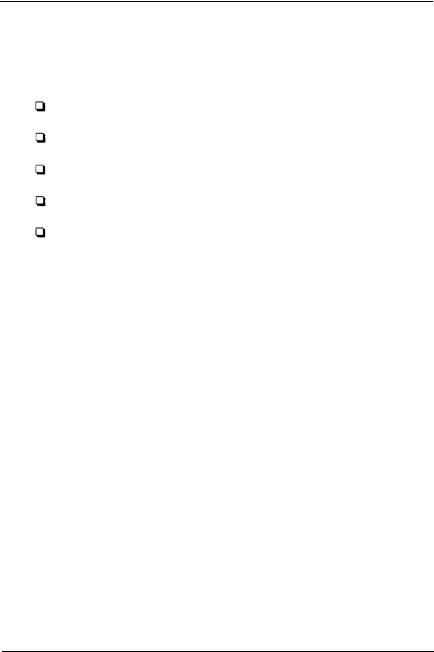
Chapter 1
Setting Up the Computer
This chapter describes how to complete the basic setup of your ActionNote computer. It covers:
Unpacking the computer
Identifying the system parts
Connecting the AC adapter
Opening the screen
Turning on the computer.
Instructions for installing optional equipment (such as a memory module or a numeric coprocessor) or connecting external equipment (such as a trackball, monitor, or printer) are provided in Chapter 4.
Setting Up the Computer 1-1

Unpacking the Computer
Your computer package contains the following:
The Epson ActionNote computer
A rechargeable battery pack (installed in the computer)
An AC adapter and power cord
A mouse/keyboard adapter for connecting an external keyboard and a pointing device at the same time
This manual, a Quick Reference guide, and the Reference diskette
A lightweight carrying case.
Depending on the configuration you purchased, your computer package may also include the following:
MS-DOS diskettes and manuals
Windows diskettes and manuals
Logitech Trackman trackball, diskette, and manual.
If your configuration includes the internal fax/modem, your package may include:
Data communications program diskette and manual
Fax transmission program diskette and manual
Telephone cable for the internal fax/modem.
Keep the packing materials and use them if you need to ship your computer later.
1-2 Setting Up the Computer

Identifying the System Parts
Before getting started, refer to the illustrations below to identify the different parts of your computer.
Front View
The main components on the front and right side of the ActionNote are shown below.
Setting Up the Computer 1-3

LCD screen
Your ActionNote has a backlit, monochrome LCD that supports VGA resolutions up to 640 x 480 dpi x 32 shades of gray.
Suspend/resume switch
Slide this switch to the right to suspend power to the computer when it is on. This places the computer in a very low power consumption state. Slide the switch to the left to return the computer to its previous state.
Brightness switch
This switch controls the brightness of the LCD screen. Slide the switch to the right to lighten the screen and to the left to darken it.
Contrast switch
This switch controls the contrast on the LCD screen. Slide the switch to the right to lighten the screen and to the left to darken it.
Keyboard area
This is where you type commands and enter data. For a full description, see Chapter 2.
Release latches
Slide these latches outward to release the top cover and open the LCD screen.
1-4 Setting Up the Computer
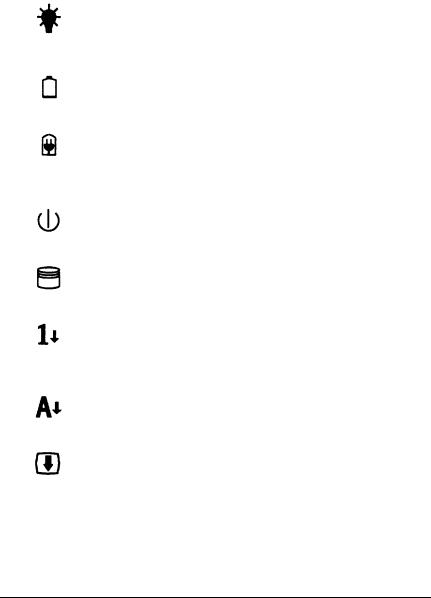
LEDs
The LEDs (light emitting diodes) on your computer provide information about its operation.
Power-Indicates the power is on; either the AC adapter or the battery pack is supplying power to the computer.
Low battery-Indicates the battery capacity is less than
20%.
Charging-Indicates the battery is fully charged; blinks when the AC adapter is connected and charging the battery.
Suspend mode-Indicates the computer is in Suspend mode.
Hard disk drive-Indicates the computer is accessing the hard disk drive.
Num Lock-Indicates that Num Lock is set on the keyboard. This activates the embedded numeric keypad on the keyboard.
Caps Lock-Indicates that Caps Lock is set on the keyboard.
Scroll Lock-Indicates that Scroll Lock is set on the keyboard.
Setting Up the Computer 1-5

Power button
This button turns the computer on and off.
DC input port
Connect the AC adapter cable here. See page 1-8 for instructions.
Release button
Press this button to eject a diskette from the drive.
Diskette drive
Your computer comes with a 3½-inch, 1.44MB diskette drive. For instructions on using diskettes, see Chapter 2.
Drive light
This light is on when the computer is accessing the diskette drive.
Rear Panel and Left Side
The components on the rear panel and left side of the computer are shown below.
1-6 Setting Up the Computer

Battery compartment cover
Turn the computer upside down and open this cover to access the battery pack. The rechargeable NiCad battery pack powers your computer when the AC adapter is not connected. For a full description, see Chapter 3.
External VGA port (VIDEO)
You can connect a VGA monochrome or color monitor to this port. The ActionNote displays information on both the LCD screen and an external monitor at the same tune.
Parallel port (PRINTER)
You can connect a parallel device, such as a printer, to this port. See Chapter 4 for instructions.
Serial port (COM 1)
This port supports a serial (RSX232C) device. See Chapter 4 for more information.
Serial/ port (COM 2)
This port supports a serial (RS-232C) device. See Chapter 4 for more information. Note that when the internal fax/modem is installed, this port is disabled.
Phone jack (LINE)
Use this standard RJ-11 jack to connect a phone line when the internal fax/modem is installed.
Setting Up the Computer 1-7

External keyboard port (EXT KB)
Use this port to connect any PS/2-compatible pointing device. This port also supports a mouse/keyboard adapter for attaching both an external PS/2-type keyboard and a pointing device at the same time. See Chapter 4 for instructions on installing optional devices.
Connecting the AC Adapter
The AC adapter is designed to be used in most countries, as it can operate in the ranges 100/240 VAC, 50/60 Hz.
Caution
Use only the AC adapter (model number AP-3S25) supplied with the computer.
If you are using the adapter in a country other than the one where you purchased your ActionNote, make sure you have the correct power cable for the electrical socket. See the power cable specifications in Appendix C for details.
You may need to connect the AC adapter to charge the battery before you use it for the first time. (See Chapter 3 for complete instructions on powering the computer with the AC adapter and/or the battery.)
1-8 Setting Up the Computer

Follow these steps to connect the adapter to the computer:
1.Connect the AC adapter plug to the DC input port on the right side of the computer.
2. Connect the power cable to the AC adapter.
3.Connect the other end of the power cable to a grounded (earthed) electrical outlet.
Setting Up the Computer 1-9
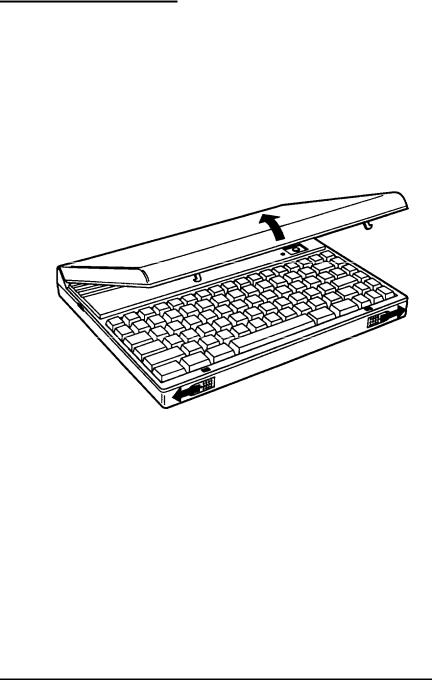
Opening the Screen
Follow these steps to open the LCD screen:
1.Place the computer on a level surface.
2.Turn the computer so its front is facing you.
3.Slide the release latches on the front sides of the computer toward the sides and lift up the screen.
1-10 Setting Up the Computer
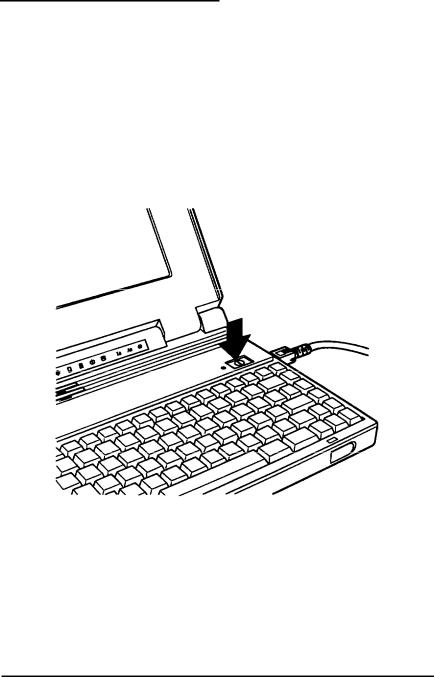
Turning On the Computer
When you first use the ActionNote, the battery may not be charged; so make sure the AC adapter is connected when you turn it on for the first time.
Before you turn on the computer, first connect and turn on any external devices you will be using-such as a printer, monitor, or pointing device. (See Chapter 4 for information about installing optional devices.) Then press the power button on the top of the computer to turn it on.
The computer displays copyright information and then performs a series of power-on diagnostics that check the circuit boards, memory, ports, keyboard, and disk drives. The computer displays several messages during the diagnostics, including this prompt:
Hit <DEL>, If you want to run SETUP
Setting Up the Computer 1-11
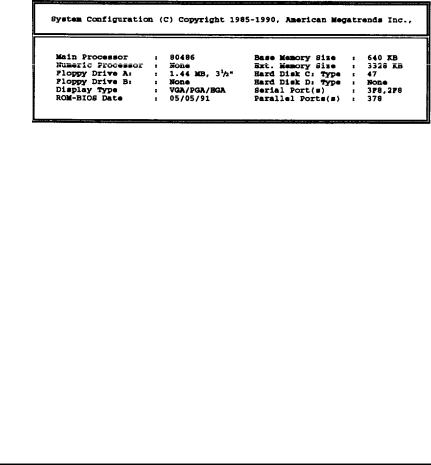
If the tests indicate a problem with the system, you will see an error message followed by this prompt:
RUN SETUP UTILITY
Press <Fl> to RESUME
If this happens, press  to run the Setup program and check your system configuration. See Chapter 5 for a complete description of the Setup program.
to run the Setup program and check your system configuration. See Chapter 5 for a complete description of the Setup program.
When the computer completes its testing it displays a screen describing the system’s configuration:
If necessary, press the  button on the keyboard to view the configuration screen. After viewing the screen, press any key to continue the startup process.
button on the keyboard to view the configuration screen. After viewing the screen, press any key to continue the startup process.
Because your computer was set up at the factory, the configuration information should be accurate. If you have changed the computer’s setup so that this information does not match your configuration, run the Setup program described in Chapter 5 to correct it.
Depending on your configuration, your computer may come with MS-DOS and Microsoft Windows installed on the hard disk. However, you can use another operating system, such as OS/2,® UNIX,® or XENIX.® Although this manual includes sample MS-DOS commands, it does not explain how to use the operating system; see your MS-DOS or other operating system manuals for complete instructions.
1-12 Setting Up the Computer
